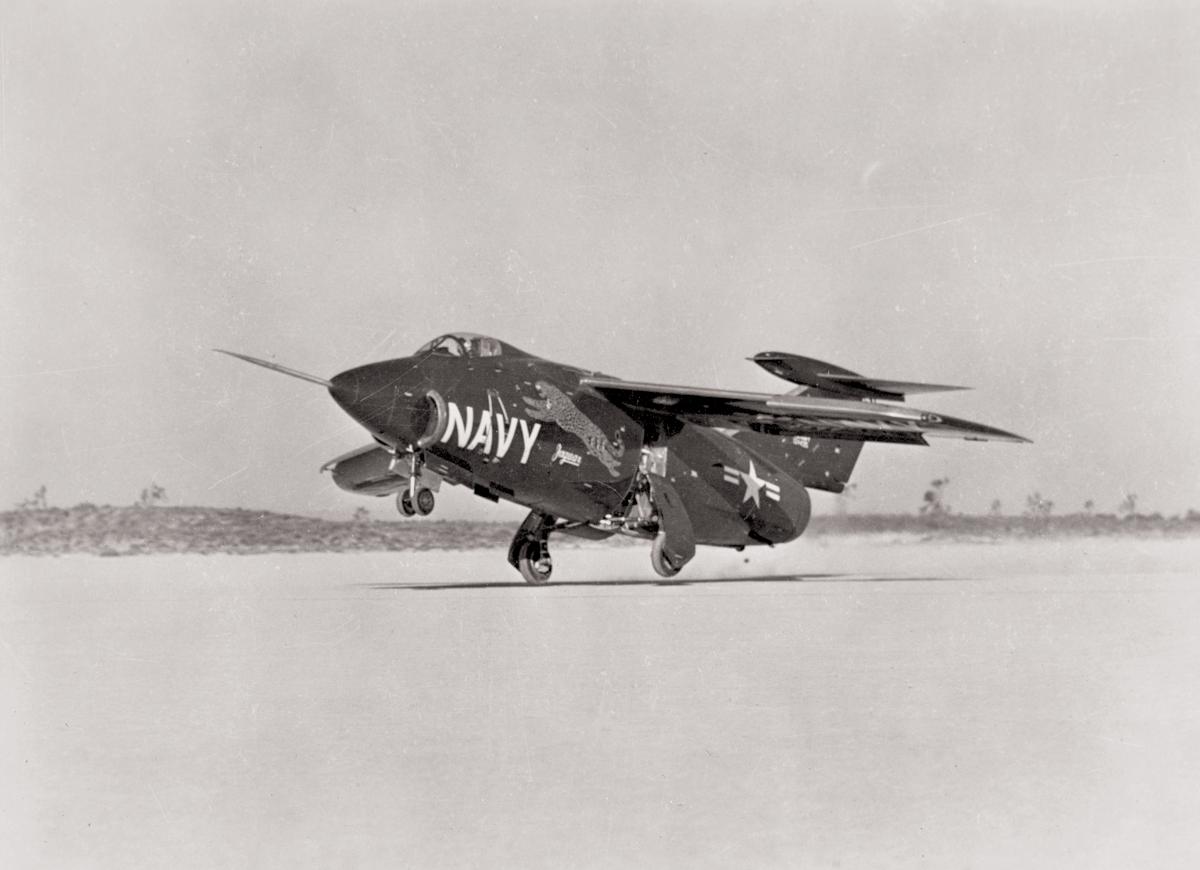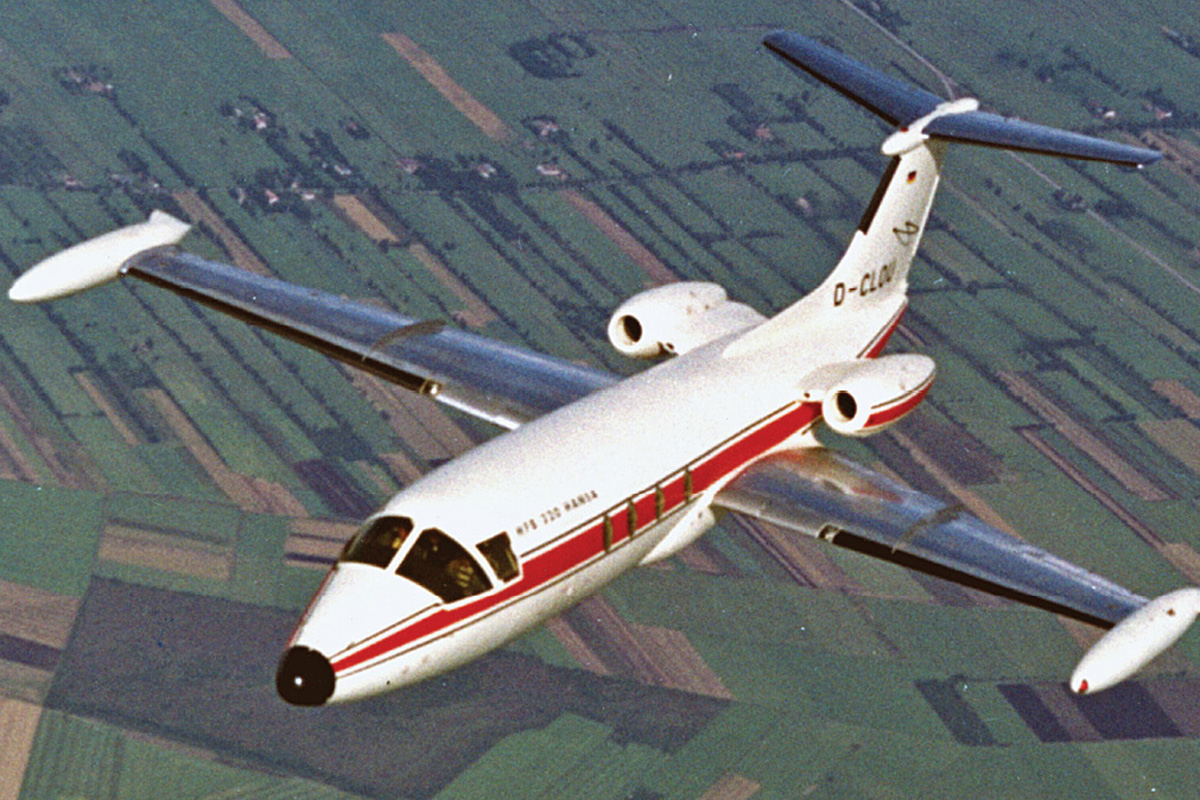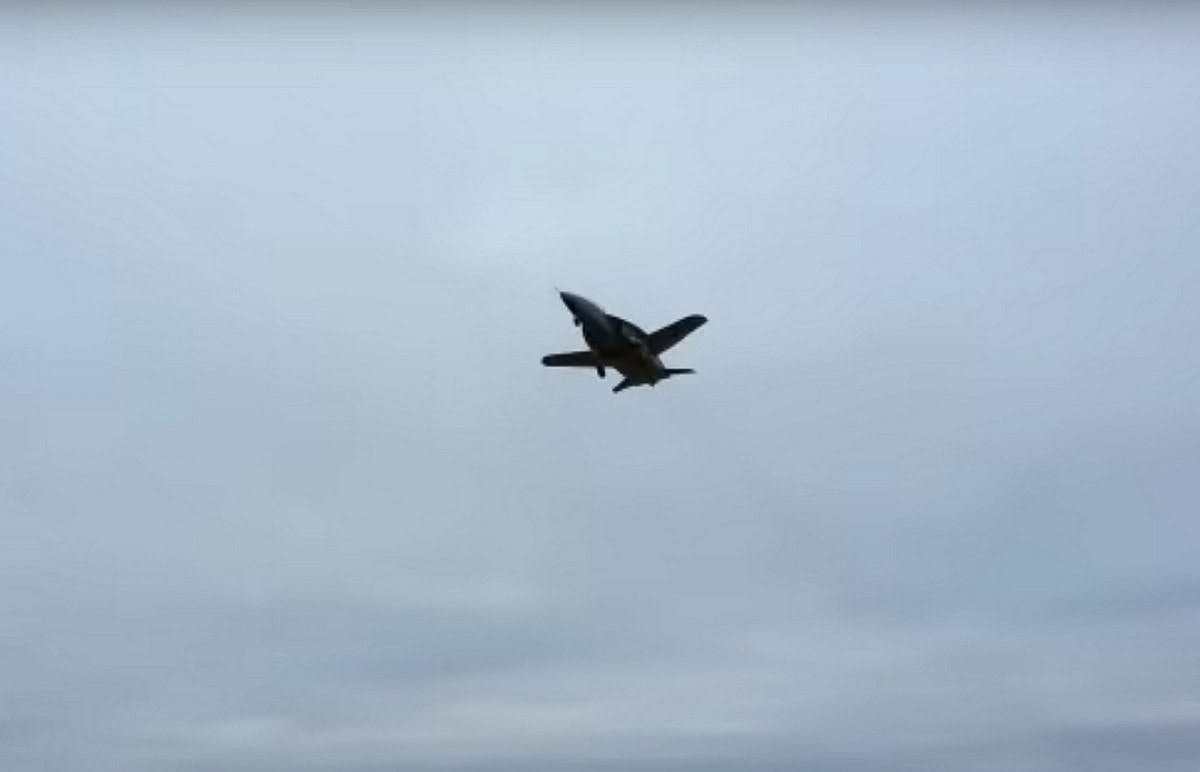Swept Wing Aircraft - Over the years, countless wing configurations have been tried and tested. Few have been successful. Learn about the different types of aircraft wing configurations and see how each wing type differs from the other, as well as the pros and cons of each.
The Cougar was the U.S. Navy's first swept wing, carrier-based, fighter jet. The XF9F-2/XF9F-3 Panther contract awarded in October of 1946 had included a clause calling for design data on a swept-wing version of that fighter.
Swept Wing Aircraft

Grumman, worried about the poor low-speed characteristics of swept-wing aircraft, prevailed upon the U.S. Navy to postpone procurement of a swept-winged version of the Panther. Development of a swept-wing Panther became more urgent as MiG-15s appeared in the skies over Korea in November of 1950. The swept-wing version of the Panther was designated F9F-6, but it was given a different name-Cougar.
Wing Structure
This continued the tradition of assigning feline names to Grumman-built fighter aircraft. It remains something of a mystery why the navy did not renumber the Cougar as the F11F-1, which was the next numerical designation available.
The aircraft wings whose leading edges are swept forward are called swept forward wings. One disadvantage of this type of configuration is that because of the flow characteristics of the wings, the outboard wings stall before the flaps.
This can cause controllability issues. Swept forward wings were therefore only used in very few aircraft, like the Grumman X-29 Switch Blade. Aircraft wings are often of complete Cantilever design. What this means is that they are built in such a way that they don't require any external bracing.
They are internally supported by structural members and the aircraft's skin. Swept wings are Mostly suitable for high speeds, like supersonic and transonic, while unswept wings work best for low speeds i.e. subsonic. Variable Sweep wings were designed to optimize flight experience over a range of speeds.
Another variant of delta wings which is popularly used in combat aircraft is the double delta. Leading edge angle of the double data is not constant but has two values. The light combat aircraft of India known as 'Tejas' uses double data wings.
Pilots undergoing stall training in jet aircraft are taught to recover at the first sign of an impending stall. Normally, this is indicated by pre-stall buffeting or by the aircraft's stick shaker, which activates at around 107 percent of the actual stall speed.

At such slow speeds, very high sink rates can develop if the aircraft pitch is decreased below the horizon, as is the normal recovery procedure in most piston-powered, straight-wing light aircraft. Therefore, at low altitudes where plenty of engine thrust is available, proper recovery in many sweptwing jets involves applying full available power on all engines, Rolling wings level, and holding a slightly positive pitch attitude.
The amount of pitch required varies by aircraft but should be sufficient to maintain altitude or begin a slight climb. The main issue that made this type of wing configuration unsuitable was that it produced wing twisting when it bent under load, putting greater stress on the wing roots.
The Sukoi Su-47 Berkut is one of the very few aircraft that used this wing. At high altitudes, where there may be little excess engine thrust available to effect a recovery using power alone, the procedure is somewhat different.
Here it may be necessary for the crew to lower the nose below the horizon in order to accelerate away from the impending stall. Some aircraft require several thousand feet or more to recover from a fully developed stall entered at high altitude.
Pilots must resist the temptation to raise the nose prematurely during recovery, since a secondary stall is likely with an increased G load experienced near the stall speed. This configuration offers highly efficient supersonic flights and has good stealth characteristics.
The only problem is that the wing loading is high which results in reduced maneuverability. The trapezoidal wing is used in the famous F-22 Raptor jet. The swept-wing version of the Panther was designated F9F-6, but it was given a different name-Cougar.
This continued the tradition of assigning feline names to Grumman-built fighter aircraft. It remains something of a mystery why the navy did not renumber the Cougar as the F11F-1, which was the next numerical designation available.
Wings are mostly constructed using aluminum but they can also be made using wood covered with fabric. Some aircraft wings are made using a magnesium alloy. In modern aircraft, stronger and lighter materials are used in wing constructions and throughout the airframe.

A Pratt & Whitney J48-P-6 turbojet engine rated at 6250 lb. thrust (dry) and 7000-lb. thrust (water injection) powered the F9F-6. It had conventional horn-balanced ailerons for lateral control and conventional tab geared elevators for longitudinal control.
Early test flights revealed that the F9F-6 had a tendency towards control reversal at high speeds, and had rather poor lateral and longitudinal control-common problems for early swept wing aircraft. The adoption of an all-flying horizontal tailplane cured the reversibility problem while the addition of "flaperon/flaperette" spoilers fitted to the upper wing surfaces solved the lateral control problems.
In normal flight, both of these spoiler sections operated as a single unit, but the flaperette section could operate independently. Large wing fences were found necessary to inhibit span-wise airflow and to preserve lateral control effectiveness.
Certain sweptwing jet aircraft are capable of entering so-called deep or super stalls, from which recovery may not be possible. Deep Stalls are the result of design characteristics that cause these aircraft to pitch up markedly after a full stall occurs.
The Disturbed airflow streaming from the stalled wing then blankets the tail, causing a loss of tailplane effectiveness. Once this happens, there is insufficient pitch control available for the pilot to lower the nose to recover.
To preclude such a situation, aircraft susceptible to deep Stalls are equipped with stick pushers that automatically do as their name implies, before the aircraft reaches a fully stalled condition. The first F9F-6 (BuNo 126670) was ready for its first flight only six months after the contract was signed.
The Cougar Flew for the first time on September 20, 1951. The National Air & Space Museum's F9F-6 (BuNo 126670) was the first Prototype built by Grumman. Short, almost vertical supports referred to as jury struts are often found on struts that are attached to the aircraft wings at a significant distance from the plane's fuselage.
They subdue strut oscillation and movement caused by the air that flows around the strut during flight. The ellipse was the shape that allowed for the thinnest possible wing, giving room inside to hold the necessary things.

In Aircrafts like the Seversky P-35, we can see a semi-elliptical wing that has a trailing or leading edge elliptical. If you are fond of airplanes or interested in learning how planes fly, you may want to learn about different types of aircraft wings or propellers used in aircrafts.
So to help you out, we are going to discuss some wing configurations, wing structure and some common types of aircraft wings. Low-speed buffet marks the Coffin corner's other "wall." It begins when the wing's angle of attack approaches its stalled condition.
This is the same kind of pre-stall buffeting that precedes a low-altitude stall in most light aircraft. At the high density altitudes associated with flight-level flying, however, low-speed buffeting will occur at higher indicated airspeeds than would be true at low altitudes.
Aircraft wings may be attached at the bottom of the fuselage, mid-fuselage or at the top. They might extend perpendicular to the fuselage's horizontal plain or can angle down or up slightly. This angle is called the wing dihedral angle and it affects the aircraft's lateral stability.
Aircraft wings are airfoils that create lift when moved rapidly through the air. Aircraft designers have created a variety of wings with different aerodynamic properties. Attached to the body of an aircraft at different angles, these wings come in different shapes.
The Elliptical wing is aerodynamically most efficient because the Elliptical spanwise lift distribution induces the lowest possible drag. However, the manufacturability of this aircraft wing is poor. One of the most famous Aircraft in which Elliptical wing was used is the Supermarine Spitfire that ruled the skies during the Battle of Britain.
Two Flying prototypes (126670 and 126672) and a Static test airframe (126671) were obtained by converting three F9F-5 airframes to the F9F-6 configuration. Work on the swept-wing Cougar proceeded quite rapidly. The first F9F-6 (BuNo 126670) was ready for its first flight only six months after the contract was signed.
The Cougar Flew for the first time on September 20, 1951. Aircraft wings lift it into the air. The particular design of the wings for any aircraft depends on several factors including the desired speed at takeoff, Landing and in flight, the desired rate of climb, use of the airplane, and size and weight of the aircraft.
For instance, the 1.3-G Buffet Boundary chart for the Boeing 737-500 aircraft shows that at FL370 and a weight of 115,000 pounds, both high- and low-speed buffet will occur at 233 KIAS while in a 1.3-G maneuver.
This obviously leaves an uncomfortably small margin for safe operation. At FL350, however, the Envelope widens considerably. Low-speed buffet occurs at 220 KIAS, while 259 KIAS marks the high-speed buffet threshold. The Cougar was the U.S.
Navy's first swept wing, carrier-based, fighter jet. The XF9F-2/XF9F-3 Panther contract awarded in October of 1946 had included a clause calling for design data on a swept-wing version of that fighter. Grumman, worried about the poor low-speed characteristics of swept-wing aircraft, prevailed upon the U.S.
Navy to postpone procurement of a swept-winged version of the Panther. Development of a swept-wing Panther became more urgent as MiG-15s appeared in the skies over Korea in November of 1950. This low aspect ratio wing is used in supersonic aircraft.
The main advantage of a delta wing is that it is efficient in all regimes (supersonic, subsonic, and transonic). Moreover, this type of wing offers a large area for the shape thereby improving maneuverability and reducing wing loading.
The margin between high- and low-speed buffet in the Coffin corner may be just a few knots, and it can even disappear altogether. Pilots are well-advised to choose a lower flight level if the Coffin corner's high- and low-speed buffet boundaries converge too closely.
Otherwise, a small increase in bank angle or an encounter with turbulence may be all it takes to induce an actual stall. The ogive wing design is used in very high-speed aircraft. The complex Mathematical shape of this aircraft wing is derived to minimize drag at supersonic speeds.
Ogive wings offer excellent performance at supersonic speeds with minimal drag. Why Sweep a wing in the first place? One natural (and correct) assumption is that it lets the airplane go faster. It does so in part by delaying the onset of the airfoil's critical Mach, the point where localized airflow over portions of the wing reaches the speed of sound before the aircraft itself does.

Exceeding critical Mach can lead to undesirable aerodynamic effects in subsonic aircraft. The most notable, perhaps, is shock-wave-induced airflow separation from the wing, with a Resultant loss of lift. Sweeping the wing allows the relative airflow over its surface to occur in a more spanwise direction.
Compared with a straight wing, the airflow Encounters less pronounced camber along this path and so doesn't Accelerate as much. This allows the aircraft itself to reach higher speeds before the wing's critical Mach is reached.
The MiG-15 was powered by derivatives of the same Rolls-Royce engine as was the Panther, but was nearly 100 mph faster. By Christmas 1950, the Navy and Grumman both agreed that it was urgent to accelerate the development of a swept-wing version of the Panther.
A contract for the modification of three F9F-5 airframes was signed on March 2, 1951. After some numerical evolution, the project was designated "Design 93." Do, for instance, such aircraft stall differently than light piston-powered aircraft with considerably less sweep?
Are the kinds of stall recoveries that we learn early in primary flight training relevant to large jet aircraft with highly sweptwing designs? After these modifications were made, the Prototype F9F-6 actually had better carrier handling characteristics than the straight-winged F9F-5.
The critical Mach number was increased from 0.79 to 0.86 at sea level and to 0.895 at 35,000 feet. The Prototype (126670) was later re-engined with a YJ48-P-8 turbojet rated at 7250 lb. thrust and no longer needed water injection.
After the first 30 aircraft were built with the J-48-P-6A, the rest were fitted with the 7250-lb. thrust J48-P-8 turbojet. Armament and stores consisted of four 20-mm M3 cannons and two wing racks that could be loaded with up to 3000 lb.
of bombs or 150-US gallon drop tanks. The first unit to receive the F9F-6 was VF-32, which converted to the Cougar in November of 1952, too late to fly combat sorties in Korea. The last of 646 F9F-6 Cougars was delivered on July 2, 1954.
A wing is a wing, of course. Each has a particular angle of attack that results in the greatest lifting efficiency, or maximum coefficient of lift. Straight or swept, the amount of lift produced decreases when this optimum angle of attack is exceeded.
If increased enough, airflow around the wing is disrupted to the point that the wing stalls. To optimize a sweptwing jet aircraft's efficiency in the high-altitude, high-speed regime where it spends the most time, aerodynamicists employ other sleight of hand, such as boundary layer strips, winglets, variable camber, and wing twist.
But there are limits to everything. Jets come up against theirs in the Coffin corner, the Morbid but well-deserved name given to the edges of their high-altitude operating envelope.
swept wing fighter, advantages of swept wing aircraft, forward swept wing aircraft, variable wing aircraft, forward swept wing, swept back wing, sweepback wings, swept wing disadvantages